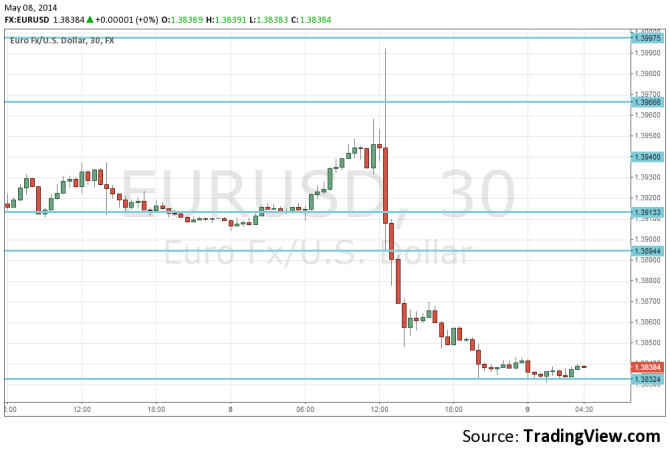EUR/USD provided a big show thanks to Mario Draghi. The decision not to cut the rates nor alter the statement pushed the pair to almost 1.40. But from there it all changed when Draghi made it clear that a move in June is imminent. The big fall of nearly 150 now raises a question: is the pair going to creep up as it usually does? Or has it begun a move south? The focus shifts to the US with the interesting JOLTS release set to provide a strong finish to the week.
Here is a quick update on the technical situation, indicators, and market sentiment that moves euro/dollar.
EUR/USD Technical
- EUR/USD licked the wounds during the Asian session and remained on low ground, above support.
Current range: 1.3830 to 1.3865.
Further levels in both directions:
- Below: 1.3830, 1.3785, 1.3740, 1.37, 1.3650 and 1.3560, 1.3515 and 1.3450
- Above: 1.3865, 1.3894, 1.3964, 1.40, 1.4055 and 1.4105
- Despite the break, 1.3964 remains the key line on the topside.
- 1.3865 is a pivotal line. True support is only at 1.3780.
EUR/USD Fundamentals
- 6:00 German Trade Balance. Exp. +16.9 billion.
- 6:45 French Government Budget Balance.
- 14:00 US JOLTS job openings. Exp. 4.21 million. See how to trade the US JOLTS number with EUR/USD.
- 14:00 US Wholesale Inventories. Exp. +0.5%.
*All times are GMT
For more events and lines, see the Euro to dollar forecast.
EUR/USD Sentiment
- The Draghi drag: the ECB did not disappoint and provided a big drama. The lack of action sent the pair to test resistance at 1.40 before it all turned negative on the presumably imminent move in June. It is still to be seen if the ECB will indeed deliver as advertised or if it will hang on to something and that this move turned into a powerful show to weaken the euro.
- Yellen cautious about economy: The Federal Reserve Chair testified twice and gave a cautious thumbs-up to the economic recovery but pointed to two sore spots – the job market remains weak and inflation is below the Fed’s target of 2%. Yellen stated that she therefore expects that low interest rate levels will continue for a “considerable time”. Yellen has stated previously that slack remains in the economy, and the Fed is expected to proceed carefully with future trims to its QE scheme. Since December, the Fed has trimmed the asset-purchase program by almost half, cutting it to $45 billion each month.
- Eurozone manufacturing sputters: Eurozone manufacturing data continues to disappoint, and of particular concern are weak figures from Germany, the Eurozone’s number one economy. German Industrial Production came in at -0.5%, well off the estimate of +0.3%. Earlier in the week, German Factory Orders slipped 2.8%, its sharpest decline since October 2012. This was nowhere near the estimate of 0.3%. French Industrial Production also looked weak, posting a decline of -0.7%, short of the forecast of 0.3%. We will get initial GDP numbers and final inflation figures next week.
- US economy: Higher hopes for Q2: The narrative of a weak US economy in Q1 due to the harsh winter (mentioned also by the Fed) versus a rebound in Q2 is strengthening: Q1 GDP was a shocking 0.1% and could be revised to contraction. On the other hand, Friday’s employment data bodes well for Q2, as Nonfarm Payrolls soared and the Unemployment Rate dropped significantly. As well, higher manufacturing and services PMIs and strong consumer confidence could signify improvement in Q2. After a nice drop in jobless claims to 319K, the focus shifts to the JOLTS number, a Fed favorite, even if it is for March.

